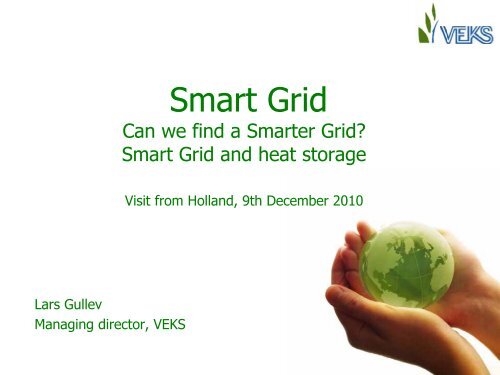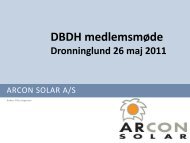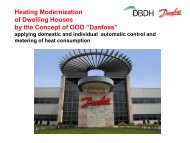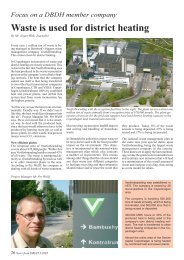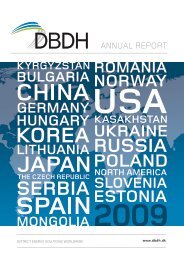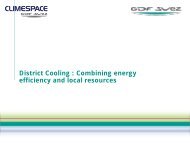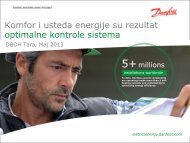District heating: smart grid and heat storage - DBDH
District heating: smart grid and heat storage - DBDH
District heating: smart grid and heat storage - DBDH
Create successful ePaper yourself
Turn your PDF publications into a flip-book with our unique Google optimized e-Paper software.
Lars Gullev<br />
Managing director, VEKS<br />
Smart Grid<br />
Can we find a Smarter Grid?<br />
Smart Grid <strong>and</strong> <strong>heat</strong> <strong>storage</strong><br />
Visit from Holl<strong>and</strong>, 9th December 2010
Agenda<br />
• What is a Smart Grid?<br />
Couldn’t it be Smarter?<br />
Why built a <strong>heat</strong> <strong>storage</strong>?<br />
Centralised <strong>heat</strong> <strong>storage</strong>.<br />
Decentralised <strong>heat</strong> <strong>storage</strong>.<br />
Summary
What is a Smart Grid?<br />
Let’s start with the Power Sector
Power system<br />
From production to end-user<br />
Thous<strong>and</strong>s of power plants generate<br />
electricity using wind energy, nuclear<br />
energy, coal, oil, natural gas, hydro <strong>and</strong><br />
a variety of other resources.<br />
Power plants produce electricity at a<br />
certain electrical voltage. This voltage is<br />
then “stepped-up” (increased) to very<br />
high voltages, such as 500 kV, to<br />
increase the efficiency of power<br />
transmission over long distances.
Power system<br />
From production to end-user<br />
Once this electrical power gets near<br />
your town or city, the electrical voltage<br />
is “stepped-down” (decreased) in a<br />
transformer to a lower voltage for<br />
distribution around your town or city.<br />
As this electrical power gets closer to<br />
your home, it is stepped-down by<br />
another transformer to the voltage you<br />
use in your home.<br />
This power enters your home through<br />
your electrical meter. The voltage in<br />
your home is typically 220/240 - 380 V.
The challange<br />
The electricity <strong>grid</strong> is getting old <strong>and</strong><br />
worn out.<br />
Population growth in some areas has<br />
caused the entire transmission system<br />
to be over used <strong>and</strong> fragile.<br />
Probably more electronic devices are<br />
added to your home, such as<br />
computers, high-definition TV’s,<br />
microwave ovens, wireless telephones,<br />
<strong>and</strong> even electronic controls on<br />
refrigerators <strong>and</strong> dishwashers.
The challange<br />
New appliances are more sensitive to<br />
variations in electric voltage than old<br />
appliances, motors, <strong>and</strong> inc<strong>and</strong>escent<br />
light bulbs.<br />
Unfortunately, the entire electrical <strong>grid</strong><br />
is becoming more fragile at the same<br />
time the appliances in your home are<br />
getting more sensitive to electrical<br />
variations.<br />
In short, the reliability of electrical<br />
power will decline unless we do<br />
something about it now.
The challange<br />
Adding new transmission lines will help the<br />
utilities get more power from the power<br />
plants to your home.<br />
However, many communities don’t want new<br />
power lines in their areas.<br />
What is needed is a new approach that<br />
significantly increases the efficiency of the<br />
entire electrical delivery system.<br />
This approach will not only increase<br />
reliability, but will also reduce energy in the<br />
delivery process <strong>and</strong> thereby reduce<br />
greenhouse house emissions.<br />
This new approach is called Smart Grid.
What is a Smart Grid?<br />
Will allow utilities to move electricity around the system as<br />
efficiency <strong>and</strong> economically as possible.<br />
Will allow the homeowner <strong>and</strong> business to use electricity<br />
as economically as possible.
What is a Smart Grid?<br />
You will have the choice <strong>and</strong> flexibility to manage<br />
your electrical use while minimizing your costs.<br />
Examples<br />
You may want to keep your house set at 22 O C in<br />
the summer time when prices are low, but you<br />
may be willing to increase your thermostat to<br />
25 O C if prices are high (cooling).<br />
You may want to dry your clothes for 5 € cents<br />
per kWh at 9:00 pm in stead of 10 € cents per<br />
kWh at 2:00 pm in the afternoon.
What is a Smart Grid?<br />
Summary<br />
To day<br />
In principle a simple upgrade of<br />
20th century power <strong>grid</strong>s which<br />
generally "broadcast" power<br />
from a few central power<br />
generators to a large number of<br />
users.<br />
Tomorrow<br />
Be capable of routing power in<br />
more optimal ways to respond<br />
to a very wide range of<br />
conditions.
What’s the problem with the concept?<br />
Couldn’t it be Smarter?
What’s the problem with the concept?<br />
Couldn’t it be Smarter?
Right…<br />
Inadequate focus on energy efficiency<br />
Low-grade energy resources are not utilized!
What we need is…..<br />
Smarter production<br />
Smarter customers<br />
Smarter tariffs<br />
Can <strong>District</strong> Energy offer that?
Yes - What we need is…..<br />
Community or <strong>District</strong> Energy
Smarter Production<br />
Low-grade energy ressources, RE <strong>and</strong> <strong>storage</strong>
Auning DH Company<br />
Heat accumulators<br />
Capacity of the small one to<br />
the right: 400 m 3 .<br />
Capacity of the larger one to<br />
the left: 1,000m 3 .
Brørup DH Company<br />
Heat accumulator with an<br />
effective volume of 1,200 m 3 .<br />
Height 14.5 m.
Energy Viborg<br />
Plant:<br />
CHP CC<br />
Power capacity of 57 MW.<br />
Heat capacity of 57 MJ/s.<br />
Heat accumulator:<br />
Effective volume of 19,000 m 3 .<br />
900 MWh <strong>heat</strong>
Smart production / customer<br />
Heat <strong>storage</strong><br />
Photo: Energi E2<br />
Volume: 22,000 m3 each<br />
Heigh: 50 m<br />
Temperature: Max 118oC Load <strong>and</strong> reload: 330 MJ/s
AVV CHP plant in Copenhagen<br />
Heat <strong>storage</strong> with effective volume of 2 * 22,000 m3 Photo: DONG Energy<br />
Centralised<br />
<strong>heat</strong> <strong>storage</strong>s
Why built a <strong>heat</strong> <strong>storage</strong>?<br />
Increase the flexibility of<br />
production facilities.<br />
Possible to produce electricity<br />
when prices at power market<br />
are high, but <strong>heat</strong> dem<strong>and</strong> is<br />
low.<br />
Possible to produce <strong>heat</strong><br />
during night time when <strong>heat</strong><br />
dem<strong>and</strong> is low.<br />
Heat dem<strong>and</strong> in the morning<br />
peak can be covered partial<br />
from reloading the <strong>heat</strong><br />
<strong>storage</strong> tank.
Why built a <strong>heat</strong> <strong>storage</strong>?<br />
Increase the flexibility of production facilities.<br />
Possible to integrate DH <strong>and</strong> wind power by using electricity for<br />
water <strong><strong>heat</strong>ing</strong> when electricity prices are low.<br />
Photo: Vattenfall
Why built a <strong>heat</strong> <strong>storage</strong>?<br />
Improve the DH company’s<br />
opportunities for making<br />
business at the market for<br />
power regulation.<br />
Availability payment for having<br />
engines st<strong>and</strong>ing in reserve to<br />
start-up, when the electricity<br />
system needs up-regulation.
Helsinge DH Company<br />
Heat accumulator with an<br />
effective volume of 2,500 m3
Smart customer<br />
Solar collectors
Smart customer<br />
System integration
Smart Tariffs<br />
Brøndby DH Company<br />
2*500 m 3 <strong>heat</strong> <strong>storage</strong> – Former fueloil tanks
Smart tariff<br />
Incentive (load-factor) to smooth the <strong>heat</strong> dem<strong>and</strong><br />
Load-factor f = 0,90 + 0,23 * Tv<br />
Tv is the annual uniformity-factor calculated as followed:<br />
Qt - <strong>heat</strong> dem<strong>and</strong>/hour.<br />
Qm - Average <strong>heat</strong> dem<strong>and</strong> for one day.<br />
Fq - Proportion between <strong>heat</strong> dem<strong>and</strong>/hour (Qt) <strong>and</strong> average<br />
<strong>heat</strong> dem<strong>and</strong>/day (Qm).<br />
For all Fq > 1.0 the uniformity-factor for the day (Td) is<br />
calculated:<br />
Td = ((Fq1 - 1,0) 2 + (Fq2 - 1,0) 2 .... + (Fq24 - 1,0) 2 ) 0,5<br />
Tv – calculated as the average of the values of Td weighted<br />
based on the <strong>heat</strong> dem<strong>and</strong>/day.
GJ<br />
1000<br />
900<br />
800<br />
700<br />
600<br />
500<br />
400<br />
300<br />
200<br />
100<br />
0<br />
GJ<br />
Calculation of load-factor for one day<br />
Average <strong>heat</strong> dem<strong>and</strong>/day (Qm) = 747,29 GJ<br />
1000<br />
900<br />
800<br />
700<br />
600<br />
500<br />
400<br />
300<br />
200<br />
100<br />
0<br />
Heat dem<strong>and</strong><br />
1 2 3 4 5 6 7 8 9 10 11 12 13 14 15 16 17 18 19 20 21 22 23 24<br />
One day<br />
Heat dem<strong>and</strong><br />
1 2 3 4 5 6 7 8 9 10 11 12 13 14 15 16 17 18 19 20 21 22 23 24<br />
One day<br />
Uniformity-factor for the day<br />
Td = 0.437791<br />
Load-factor for the day<br />
f = 0.90+0.23*0.437791<br />
= 1.000692<br />
Uniformity-factor for the day<br />
Td = 0.0<br />
Load-factor for the day<br />
f = 0.90
Load-factor<br />
Development in load-factor<br />
1,01<br />
1,00<br />
0,99<br />
0,98<br />
0,97<br />
0,96<br />
0,95<br />
0,94<br />
0,93<br />
0,92<br />
0,91<br />
1 2 3 4 5 6 7 8 9 10 11 12 13 14 15 16<br />
Years<br />
Brøndby DH Company Average VEKS consumer
Smart Tariff<br />
Smooth the <strong>heat</strong> dem<strong>and</strong><br />
Smaller pipe dimensions in the<br />
DH transmission network.<br />
Reduce the pumping costs.<br />
Reduce the need for peak-load<br />
production.<br />
Possibility for reduced flow<br />
temperature.
Greater Copenhagen DH System<br />
18 18 municipalities<br />
municipalities<br />
4 4 integrated integrated systems<br />
500,000 500,000 end end – – users users<br />
34,500 34,500 34,500 TJ TJ (9,600 (9,600 GWh, GWh,<br />
32,700 32,700 GBtu) GBtu)<br />
Heat <strong>storage</strong>
Load dispatching<br />
-2008<br />
The duty to secure the optimisation of<br />
the total <strong>heat</strong> <strong>and</strong> power production in<br />
Greater Copenhagen (CPH) belonged<br />
to the power company DONG Energy.<br />
As a consequence of the liberalisation<br />
of the electricity market the company<br />
Vattenfall bought one of the CHP<br />
plants in CPH.<br />
Two power companies in competition<br />
with each other on the DH market in<br />
CPH.<br />
Another body had to take over the<br />
responsibility for securing the total<br />
optimisation of the <strong>heat</strong> <strong>and</strong> power<br />
production.<br />
DONG<br />
Vattenfall
Varmelast.dk - Background<br />
Four different main principles of load<br />
dispatching <strong>and</strong> pricing were analyzed:<br />
The preconditions for an efficient, liberalised<br />
DH market is not present in the Greater<br />
Copenhagen area's DH system. Producers will<br />
have market power, which gives theoretical<br />
possibility of increasing DH payments with up to<br />
30 million €/year.<br />
The economic impact of splitting the <strong>heat</strong><br />
market in two areas supplied by each<br />
producer could be increased DH costs in size<br />
from 4 to 10 million €/year. This is because the<br />
DH transmission network is not utilised optimal<br />
with this principle.
Varmelast.dk - Background<br />
Four different main principles of load<br />
dispatching <strong>and</strong> prizing were analyzed:<br />
One single <strong>heat</strong> price / volume agreement<br />
would also likely lead to increasing DH prices. Such<br />
an agreement would not address the fundamental<br />
problems with collaboration between commercial<br />
producers on load dispatch.<br />
One coherent market with DH companies as<br />
load dispatchers based on an overall<br />
optimization of <strong>heat</strong> <strong>and</strong> power production <strong>and</strong><br />
agreed sharing of the benefits coming from CHP<br />
production seemed to imply most advantages <strong>and</strong><br />
fewest disadvantages for the DH consumers.
Varmelast.dk (Heat-load.dk)<br />
An important DH operator in Greater Copenhagen<br />
2008-<br />
Concrete cooperation – named<br />
Varmelast.dk - between the DH<br />
companies in Greater CPH - VEKS,<br />
CTR <strong>and</strong> KE - started.<br />
The task for the cooperation was to<br />
secure the economical optimisation<br />
of the <strong>heat</strong> <strong>and</strong> power production in<br />
Greater CPH.<br />
Varmelast.dk went into operation 7<br />
January 2008 by taking care of the<br />
optimisation of the water based DH<br />
system.<br />
Since 27 April 2009 Varmelast.dk has<br />
also been responsible for<br />
optimisation of the steam based DH<br />
in the area.<br />
DONG<br />
Vattenfall
Varmelast.dk - Responsibility<br />
Planning the next operating day in<br />
collaboration with the owners of the<br />
CHP plants.<br />
Adjust the <strong>heat</strong>-plans at 8 am, at 3:30<br />
pm <strong>and</strong> at 10 pm.<br />
Daily operational monitoring.<br />
Developing tools for joint optimisation.<br />
Securing the necessary data base.<br />
Cooperation with VEKS <strong>and</strong> CTR<br />
control room <strong>and</strong> back office functions<br />
for each of the three companies –<br />
VEKS, CTR <strong>and</strong> KE.<br />
DONG<br />
Vattenfall
Varmelast.dk - Challange<br />
First <strong>and</strong> foremost maintain<br />
confidentiality between the parties,<br />
who also acts in the electricity<br />
market.<br />
Ensure an optimal production of both<br />
electricity <strong>and</strong> <strong>heat</strong>, taking into<br />
account priority <strong>heat</strong> from waste<br />
incineration plants <strong>and</strong> the<br />
geothermal plant.<br />
Ensure that three integrated DH<br />
systems play together <strong>and</strong> that all<br />
customers constantly around the<br />
clock are supplied with DH.<br />
DONG<br />
Vattenfall
Varmelast.dk – Daily <strong>heat</strong>-plan<br />
The <strong>heat</strong>-plan is based on <strong>heat</strong><br />
dem<strong>and</strong> <strong>and</strong> the total production<br />
costs.<br />
The tender procedure for the next day<br />
starts before 8 am when forecasts for<br />
next day's water <strong>and</strong> steam<br />
production are sent to the producers.<br />
Later Varmelast.dk receives tenders<br />
from both producers.<br />
DONG<br />
Vattenfall
Varmelast.dk – Daily <strong>heat</strong>-plan<br />
Varmelast.dk calculates the cheapest way<br />
to get <strong>heat</strong> dem<strong>and</strong> covered <strong>and</strong> order the<br />
desired quantity of hot water <strong>and</strong> steam<br />
from each of the producers.<br />
Producers calculate the cheapest way to<br />
meet Varmelast.dk 's order for DH water<br />
<strong>and</strong> steam hour by hour, taking into<br />
account:<br />
Production of electricity,<br />
Fuel prices,<br />
CO 2 quotas<br />
Energy taxes<br />
DONG<br />
Vattenfall
Varmelast.dk – Daily <strong>heat</strong>-plan<br />
Varmelast.dk receives preliminary<br />
<strong>heat</strong>-plans from the producers.<br />
The plans are corrected with<br />
regard to hydraulic limitations in<br />
the DH network <strong>and</strong> optimum<br />
utilization of the <strong>heat</strong><br />
accumulators at the two CHP<br />
plants AMV <strong>and</strong> AVV based on the<br />
basis of marginal costs.<br />
DONG<br />
Vattenfall
Varmelast.dk – Daily <strong>heat</strong>-plan<br />
The final <strong>heat</strong>-plans are sent to each<br />
producer with an indication of <strong>heat</strong><br />
production for each block hour by<br />
hour for the next day.<br />
Heating-plan must be in place within<br />
am 10.30, to ensure that the<br />
producers know how much <strong>heat</strong><br />
they have to produce – <strong>and</strong> thus<br />
how much electricity they can offer<br />
for sale on the power pool - Nord<br />
Pool.<br />
DONG<br />
Vattenfall
Why is DH a “Smarter Grid”?<br />
Utilise low-grade energy resources<br />
<strong>and</strong> hereby reduce the consumption<br />
of primary resources.<br />
Increase the integration between RE<br />
(biomass, solar, wind, geothermal<br />
energy) <strong>and</strong> DH.<br />
Flexibility.
Thank you<br />
Further information:<br />
www.veks.dk<br />
lg@veks.dk


